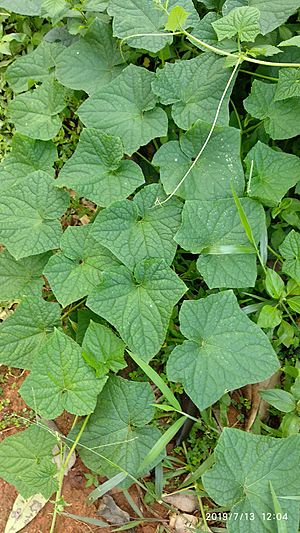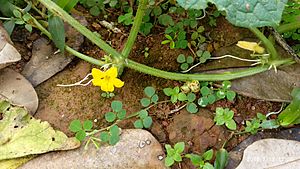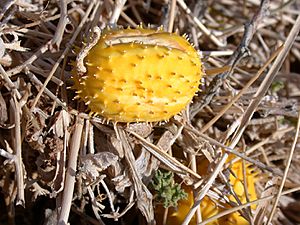Cucumis prophetarum facts for kids
Quick facts for kids Cucumis prophetarum |
|
|---|---|
 |
|
| Leaves of the prophet's cucumber | |
| Scientific classification | |
| Genus: |
Cucumis
|
| Species: |
prophetarum
|
The prophet's cucumber (Cucumis prophetarum) is a type of vine. It belongs to the Cucurbitaceae family, also known as the gourd family. This plant is a dioecious perennial. This means it has separate male and female plants. It can grow along the ground or climb. It lives for many years.
Where It Grows
The prophet's cucumber is found in many parts of the world. It grows naturally in Mauritania in the west. Its range extends east to the Horn of Africa. It also goes southwest to Angola. You can find it in northern South Africa and southern Mozambique. It is also native to the Comoros islands and northern Egypt.
In Asia, it grows in Israel and southern Lebanon. It is also found in southern Saudi Arabia, Yemen, Oman, and the United Arab Emirates. It reaches northwestern India. This plant has also been brought to Qatar.
What It Looks Like
The stems and leaves of the prophet's cucumber are hairy. The leaves are oval or round in shape. Their bases are heart-shaped. They usually measure 2–4 centimeters long. Each leaf has 3–5 rounded sections.
Male flowers grow in groups of 2 or 3. Sometimes, a male flower grows alone. Female flowers always grow by themselves. Both types of flowers have five yellow petals.
The fruit is a bit oval-shaped. It has vertical stripes and turns yellow when it is ripe. The fruit is about 3–4 centimeters long. It is covered in small, spike-like bumps. This plant grows wild in semi-desert areas. It can be found in bushland and grassland. It often grows near acacia trees. It can grow at high elevations, up to 2010 meters (6594 feet).
How People Use It
The fruit of the prophet's cucumber tastes bitter when it is raw. Sometimes, people boil or pickle the fruit. The leaves can also be cooked and eaten with other foods.
People in its native regions eat the fruit. It is sometimes grown and sold in local markets.
The fruit is also used in traditional medicine. In Saudi Arabia, it has been used to help with liver problems. Scientists have studied an extract from the fruit. This extract showed that it might help fight certain types of unhealthy cells. Another extract from the fruit might help with blood sugar levels.



